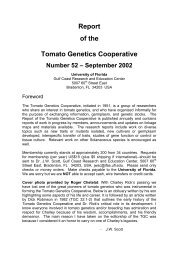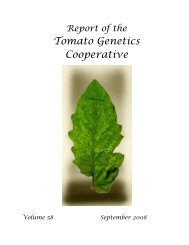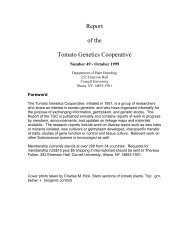Volume 60 - Tomato Genetics Cooperative - University of Florida
Volume 60 - Tomato Genetics Cooperative - University of Florida
Volume 60 - Tomato Genetics Cooperative - University of Florida
You also want an ePaper? Increase the reach of your titles
YUMPU automatically turns print PDFs into web optimized ePapers that Google loves.
chamber with 24C/ 20C day/night temperature and 18/6 hours day/night photoperiod<br />
(Fig. 1).<br />
<strong>Tomato</strong> flower preparation for confocal microscopy:<br />
A 0.1% aqueous solution <strong>of</strong> calc<strong>of</strong>luor white (SIGMA) was made (Pringle 1991).<br />
Excess solution was kept in the freezer and defrosted as needed. Excised floral<br />
structures (petals, anthers or filaments) were immersed in approximately 5 ml <strong>of</strong> 0.1%<br />
calc<strong>of</strong>luor solution and placed under vacuum until rapid boil was achieved. The sunken<br />
specimens were allowed to soak for 20 minutes in the dark and then were rinsed in<br />
dH2O for 10 minutes. Specimens were dissected and placed on slides. For the anthers,<br />
spacers <strong>of</strong> approximately 0.5 mm – 1 mm thick were used to ensure the specimens<br />
were not smashed by the coverslip. Coverslips were placed on top and fixed with nail<br />
polish at each corner. Calc<strong>of</strong>luor staining <strong>of</strong> epidermal cell walls was observed using the<br />
DAPI channel <strong>of</strong> the confocal laser-scanning microscope (CLSM) (FV1000). Images<br />
were taken at the planes in which cell wall margins contacted each other. Cells were<br />
counted in image frames measuring from 150 m X 150 m to 300 m X 270 m, with<br />
the frame size adjusted as needed to include from five to twenty cells in each frame.<br />
Ten to fifteen cells from both sides (abaxial and adaxial) <strong>of</strong> each floral structure<br />
were measured using ImageJ (Rasband, 2009) to obtain cell areas (in m 2 ). The<br />
ANOVA and Tukey's LSD statistical tests (Minitab, Inc.) were performed separately for<br />
each epidermal floral surface across genotypes to determine if any significant difference<br />
existed between the mean surface areas <strong>of</strong> studied epidermal cells.<br />
Results<br />
Petal abaxial cell surface area was significantly different among the three<br />
genotypes (p < 0.001) with CMS line having the largest mean cell size and S. pennellii<br />
having the smallest (Figs. 2, 3). Petal adaxial cell sizes differed significantly with S.<br />
lycopersicum and S. pennelli both being larger than the CMS line (Fig 3). Although no<br />
statistical test was done, abaxial cells were smaller than the adaxial in the two species<br />
S. pennellii and S. lycopersicum. On the contrary, the abaxial cells in the CMS line<br />
were larger in comparison to the adaxial cells.<br />
Epidermal cell area on both the adaxial and the abaxial surfaces <strong>of</strong> the anthers<br />
was significantly different (p< 0.001) among the three genotypes (Figs.4, 5), with S.<br />
lycopersicum having the largest mean cell size for both, and the CMS line, the smallest.<br />
Among the filament epidermal cells, the abaxial cells in the CMS line and<br />
cultivated tomato were not significantly different, but both were significantly bigger than<br />
those in S. pennellii (p< 0.001) (Fig.6, 7). There were no significant differences in the<br />
mean size <strong>of</strong> the epidermal cells on the adaxial surface <strong>of</strong> the filaments <strong>of</strong> the three<br />
strains (p=0.252) (Fig.5, 6). There was a large variation (Fig. 7) in the size <strong>of</strong> the adaxial<br />
epidermal cells in S. pennellii and the CMS line, while the size <strong>of</strong> the adaxial cells <strong>of</strong><br />
filament in the cultivated tomato showed less variation.<br />
Discussion<br />
According to published data, cytoplasmic male sterility has a considerable effect<br />
on the size and color <strong>of</strong> petals and stamens (Kaul 1988, Farbos et al. 2001, Leino et al.<br />
2003). Our previous studies had also shown that in comparison to S. pennellii, the CMS<br />
59





